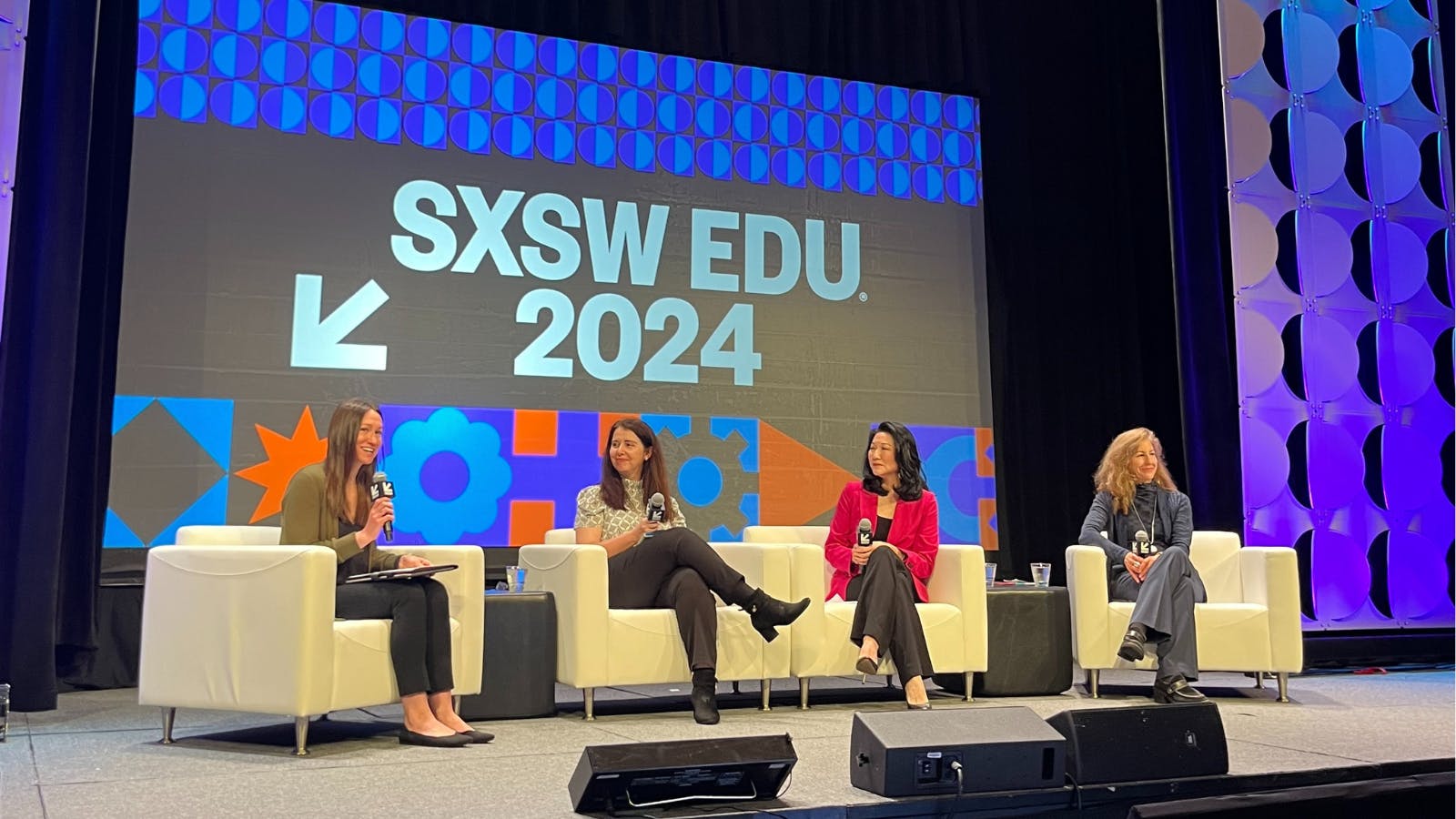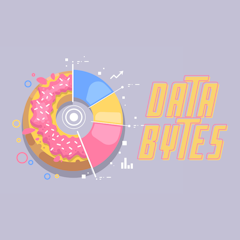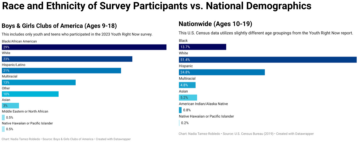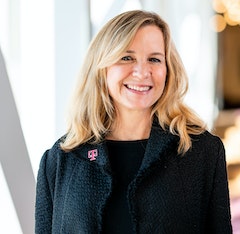
Since ChatGPT was released in November 2022 and exploded into public discourse, the emergence of generative AI tools has been met with both excitement and concern, across virtually every industry, ideology and age group.
Today, the use of this technology in education settings is underway, and states are even beginning to release guidance on how to navigate AI in schools. Over the past year, the tone of that guidance has shifted from skepticism and resistance to acceptance and optimism, according to an analysis from the Center for Reinventing Public Education.
The fervor around AI was on full display at the SXSW EDU conference held in Austin, Texas, during the first week of March. At least 20 sessions had the term “AI” in their title.
While the vast majority of the conversations about AI in education have centered on K-12 and higher education, few have considered the potential of this innovation in early care and education settings.
At the conference, a panel of early education leaders gathered to do just that, in a session exploring the potential of AI to support and empower the adults who help our nation’s youngest children, titled, “ChatECE: How AI Could Aid the Early Educator Workforce.”
A summary of the discussion follows. For the full conversation, listen here.
At a time when early childhood educators are experiencing a host of challenges — from burnout, to low pay, to understaffed programs — the panelists discussed ways that AI can safely and effectively free up educators’ time and lend them more support.
Michelle Kang, CEO of the National Association for the Education of Young Children (NAEYC), a professional membership organization that promotes high quality early learning for all children, noted that AI can save educators time by helping them write weekly newsletters to families.
This practice is already happening in K-12 settings, said Isabelle Hau, executive director of the Stanford Accelerator for Learning.
Hau shared that K-12 educators are using the technology to improve efficiency in a number of ways, including to draft individualized education programs (IEPs), create templates for communicating with parents and administrators, and in some cases, to support building lesson plans.
(Hau, a non-native English speaker, shared that she has used ChatGPT to improve her own written communication — and that friends and colleagues have noticed and complimented her on it.)
“I would love to see that happening a little bit more in the early years, because if we could save some of our early educators time — to spend even more time with our little ones — I think we would all benefit,” Hau said.
Kang also pointed out that generative AI can be used to overcome language barriers — for example, by providing live translation services during a meeting or translating written communication into a language spoken by a child’s family before sending it. This, she noted, is important in early learning because many educators serve families that speak multiple languages.
This technology can also help educators support families, Kang added, by scanning publicly available community resources and identifying relevant library events, food banks, free clinics and the like. Or if a child is fascinated with, say, dinosaurs or trees, AI can provide parents and educators with prompts for further learning or perhaps connect them to the nearest natural history museum or arborist.
Celia Stokes, president of product at Teaching Strategies, shared that her company — which provides early childhood curriculum, assessment, professional learning and family engagement solutions — is focused on practical applications of AI so early childhood educators have more time to focus on building strong relationships with children, which no technology can begin to replace.
Still, with so many other pressing concerns in the field, few early childhood educators are hungry for AI, the panelists admitted.
“It’s a little bit like, before the iPhone was created, asking people if they wanted all their songs in their pockets,” Stokes said. “It’s hard to imagine what’s possible until you create some very specific wins that move the needle.”
“It’s not top of mind for many educators,” Kang acknowledged. “There is curiosity and trepidation alongside, ‘Is this something else that I now need to get my head around?’ We’re all still trying to unpack that, and that’s where many educators are like, ‘How can this actually impact what my daily experience is right now?’”
Hau thinks that may well change.
“I find that educators are generally innovators,” Hau said. “They want to do the best for their kids. They are looking for how they could improve their practices, how they could improve their craft.”
So if an early childhood educator sees that AI can save her meaningful amounts of time — time that she can then channel back into direct, quality interactions with the children in her care — then she is likely to become interested in it.
The panelists agreed that, even if there are opportunities for AI to aid early childhood educators, every step to integrate it must be measured, intentional and appropriate.
Stokes shared that her company is already guided by a slow, thoughtful approach.
“We could be doing a lot of things a lot faster,” she explained. “What we’re doing is [taking] things slowly and carefully and rolling them out internally and then with pilot testers to make sure that when a teacher asks a question [to a chatbot], she’s getting the right answer back.”
Panelists raised concerns as well: What are the ethical guidelines? What source data is being used? What are the privacy and safety implications, for adults and children? When so many other technologies — and so many existing systems in the United States — are already inherently inequitable, will AI only exacerbate that?
Despite their concerns, Kang, Hau and Stokes acknowledged that AI isn’t going away. And that there are already simple, innocuous applications available to the early educator workforce.
“It doesn’t need to be scary if we just talk about the real possibilities, the things that are not controversial,” Stokes said. “It is not about putting a robot in front of your child and losing control over everything. It is about very practical ways to help adults do hard things better, faster, easier.”
- SEO Powered Content & PR Distribution. Get Amplified Today.
- PlatoData.Network Vertical Generative Ai. Empower Yourself. Access Here.
- PlatoAiStream. Web3 Intelligence. Knowledge Amplified. Access Here.
- PlatoESG. Carbon, CleanTech, Energy, Environment, Solar, Waste Management. Access Here.
- PlatoHealth. Biotech and Clinical Trials Intelligence. Access Here.
- Source: https://www.edsurge.com/news/2024-03-18-can-ai-aid-the-early-education-workforce
- :has
- :is
- :not
- :where
- $UP
- 20
- 2022
- a
- About
- accelerator
- acceptance
- According
- acknowledged
- across
- actually
- added
- administrators
- admitted
- adults
- age
- agreed
- AI
- ai in education
- Aid
- All
- alongside
- already
- also
- amounts
- an
- analysis
- and
- answer
- applications
- approach
- appropriate
- ARE
- around
- AS
- asking
- assessment
- Association
- At
- austin
- available
- away
- back
- Banks
- barriers
- BE
- because
- become
- been
- before
- begin
- Beginning
- being
- benefit
- BEST
- Better
- Bit
- both
- Building
- by
- CAN
- care
- carefully
- cases
- Center
- centered
- ceo
- change
- Channel
- chatbot
- ChatGPT
- child
- Children
- clinics
- colleagues
- communicating
- Communication
- community
- company
- Concern
- Concerns
- Conference
- Connect
- considered
- control
- controversial
- Conversation
- conversations
- could
- craft
- create
- created
- curiosity
- Curriculum
- daily
- data
- Dinosaurs
- direct
- Director
- discourse
- discussed
- discussion
- Display
- do
- doesn
- doing
- draft
- during
- Early
- easier
- Education
- educators
- effectively
- efficiency
- else
- emergence
- empower
- engagement
- English
- ethical
- Even
- events
- Every
- everything
- exacerbate
- example
- Excitement
- executive
- Executive Director
- existing
- experience
- experiencing
- explained
- Exploring
- families
- family
- faster
- fervor
- few
- field
- Find
- First
- Focus
- focused
- follows
- food
- For
- Free
- friends
- from
- front
- full
- further
- gathered
- generally
- generative
- Generative AI
- get
- getting
- going
- Group
- guidance
- guided
- guidelines
- had
- Happening
- Hard
- Have
- head
- Held
- help
- helping
- her
- High
- higher
- Higher education
- history
- How
- How To
- HTTPS
- Hungry
- i
- identifying
- if
- imagine
- Impact
- implications
- important
- improve
- in
- Including
- individualized
- industry
- inherently
- Innovation
- innovators
- integrate
- Intentional
- interactions
- interested
- internally
- into
- iPhone
- IT
- just
- kids
- language
- Languages
- leaders
- learning
- least
- LEND
- lesson
- Library
- like
- likely
- little
- live
- looking
- losing
- Lot
- love
- Majority
- make
- many
- March
- May..
- meaningful
- measured
- meeting
- membership
- met
- mind
- more
- move
- multiple
- Museum
- must
- my
- National
- Nations
- Natural
- Navigate
- Need
- news
- Newsletters
- no
- non-native
- noted
- noticed
- November
- now
- number
- of
- on
- ones
- only
- opportunities
- Optimism
- or
- organization
- Other
- our
- out
- over
- Overcome
- own
- panel
- parents
- past
- People
- perhaps
- pilot
- plans
- plato
- Plato Data Intelligence
- PlatoData
- pockets
- possibilities
- possible
- potential
- Practical
- Practical Applications
- practice
- practices
- president
- pressing
- privacy
- Product
- professional
- Programs
- promotes
- prompts
- provide
- provides
- providing
- public
- publicly
- Putting
- quality
- question
- raised
- RE
- real
- Relationships
- released
- relevant
- replace
- Resistance
- Resources
- right
- robot
- Rolling
- s
- safely
- Safety
- Said
- Save
- say
- scanning
- Schools
- see
- sees
- sending
- serve
- Services
- session
- sessions
- settings
- shared
- she
- shifted
- Simple
- Skepticism
- slow
- Slowly
- So
- Solutions
- some
- something
- songs
- Source
- speak
- Speaker
- specific
- spend
- spoken
- stanford
- States
- Step
- Still
- strategies
- strong
- SUMMARY
- support
- sure
- Systems
- T
- taking
- Talk
- teacher
- Teaching
- Technologies
- Technology
- templates
- term
- testers
- texas
- that
- The
- their
- Them
- then
- There.
- they
- things
- Think
- Thinks
- this
- time
- Title
- titled
- to
- TONE
- tools
- top
- Translation
- Trees
- trying
- Underway
- United
- United States
- until
- use
- used
- using
- Vast
- very
- virginia
- virtually
- want
- wanted
- was
- ways
- we
- week
- weekly
- WELL
- What
- when
- which
- WHO
- will
- Wins
- with
- Workforce
- would
- write
- written
- year
- years
- you
- young
- Youngest
- Your
- zephyrnet












